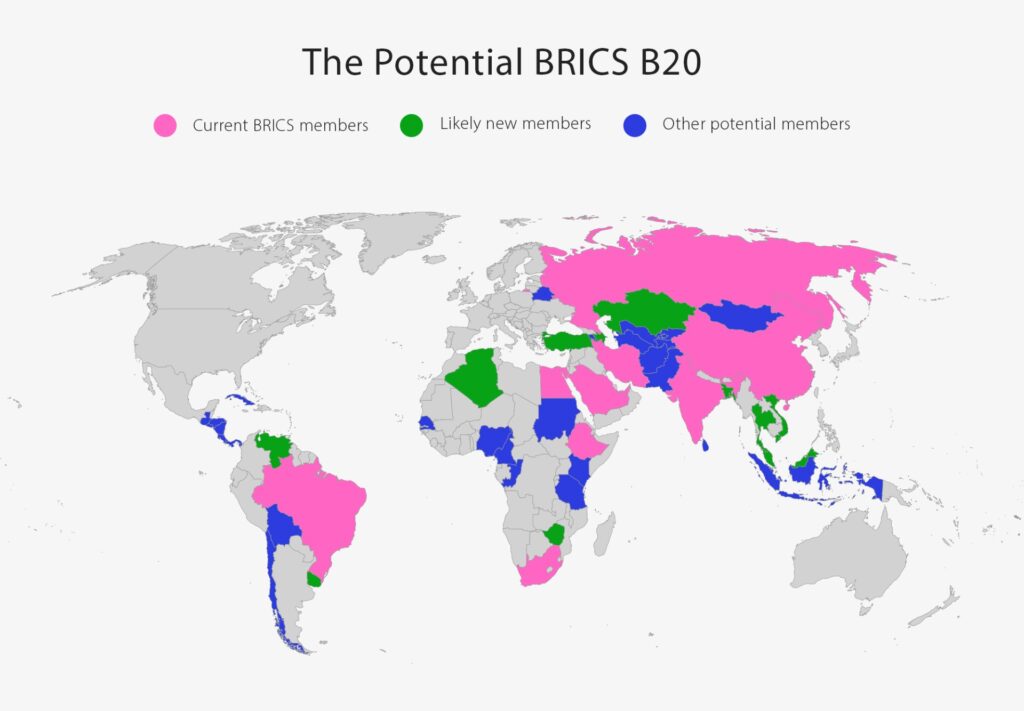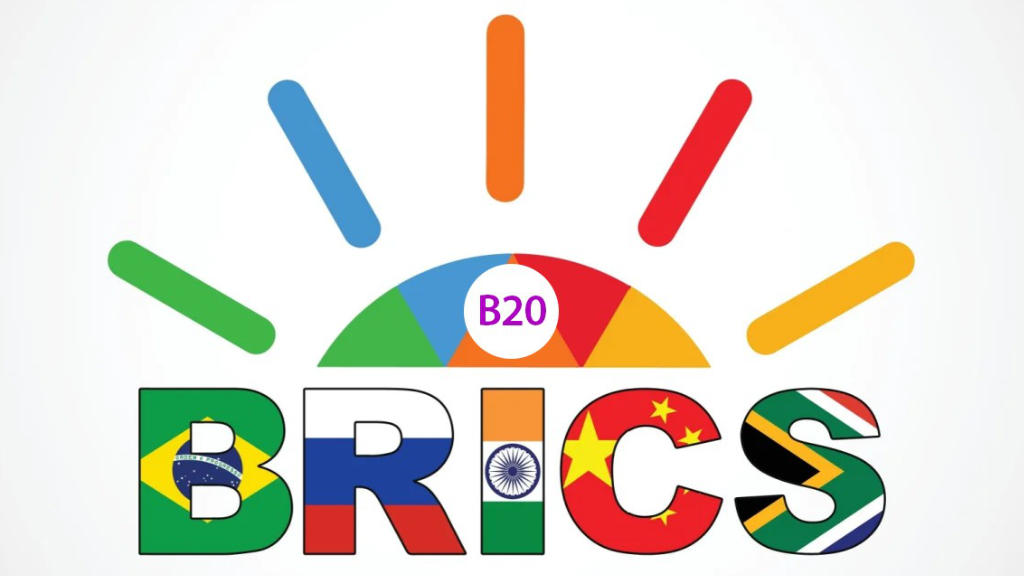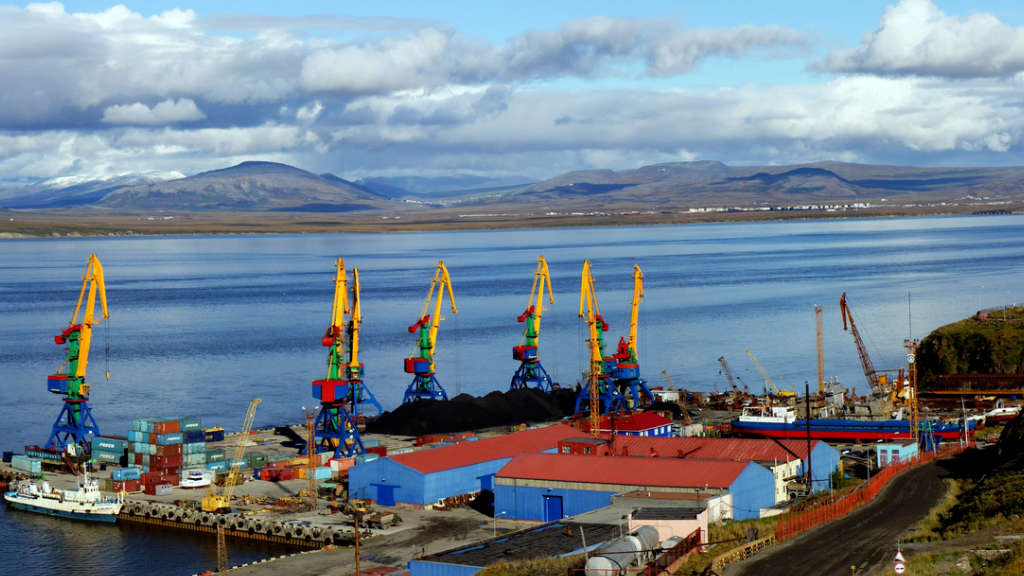The BRICS tenth parliamentary forum has been taking place in St. Petersburg, with major structural changes being discussed to manage the blocs development. Russia is the current chair of the forum, which was presided over by the Russian President, Vladimir Putin. He stated that “Thus far, BRICS does not have its own institutionalized parliamentary structure. But I believe that in the future this idea will definitely be realized.” Elsewhere, Wu Yuhua, Executive President of China’s SYIFA Council of Foreign-Invested Enterprises, said BRICS could become the “B20”, – being much more effective and attractive than the G20 group of leading economies.
Such developments would place BRICS on a bloc par with the G20, yet organised in the format of NATO. BRICS however is a multi-faceted, global trade organisation – the Eurasian security issues of members China, India and Russia are dealt with as part of the Shanghai Cooperation Organisation remit. The SCO concluded its annual Heads of State meetings last week. However, squaring the circle between BRICS and the SCO has already been discussed – with some members proposing the merger of the two blocs, in conjunction with the Eurasian Economic Union into one larger entity.
Who would comprise the B20?
The question then becomes not just the Parliamentary development – but who the B20 would include. There are strong existing indicators. BRICS already counts Brazil, China, Egypt, Ethiopia, India, Iran, Russia, Saudi Arabia, South Africa and the UAE as full members. Doubling this to twenty can be expected to include Bangladesh and Uruguay, who have both taken up participation in the BRICS New Development Bank and are presumably just a step away from joining having financially committed. In addition, multiple other countries have also expressed official interest in joining.
Sergey Lavrov, Russia’s Foreign Minister, has previously stated but countries need to be prepared and qualified to join BRICS, which may exclude for the time being Sri Lanka, who has indicated willingness to join but is still involved in refinancing its existing foreign debt. Other countries may also not yet be quite stable as concerns their overall fiscal stability – the next batch of members will be expected to contribute as well as gain.
An interesting candidate would be Turkiye, which although a NATO member could offer a great deal as new trade routes develop, and especially between Russia, China, Central Asia, and the Middle East. It is also a major, and influential economy. Azerbaijan and Kazakhstan are other strong candidates for similar transportation and transit reasons.
In Africa, Algeria has expressed interest and is a major energy play, while Zimbabwe would offer access to Central and South Eastern Africa.
Venezuela and Ecuador have both shown intent, with Ecuador negotiating Free Trade Agreements with both China and the Eurasian Economic Union. It would make sense to substitute these with a looser BRICS arrangement.
In Southeast Asia, some of ASEAN’s largest economies have applied to join, including Malaysia, Thailand and Vietnam.
These are probably the closest next ten members, however it should be noted that countries as diverse as Afghanistan, Bolivia, Cameroon, Congo, Chile, Costa Rica, Cuba, El Salvador, Guatemala, Honduras, Indonesia, Kenya, Mongolia, Nicaragua, Nigeria, Pakistan, Panama, Peru, Senegal, Sudan, Tajikistan, Tanzania, Turkmenistan, and Uzbekistan are all known to have at a minimum expressed interest. Some of these have formally applied. There are almost certainly others. Russian Federation Council Speaker Valentina Matviyenko said on Thursday (July 11) that “24 countries, if I’m not mistaken, are now in line to join BRICS. I don’t rule out that the CIS states may become BRICS members in the future.” The CIS states currently include Armenia, Azerbaijan, Belarus, Kazakhstan, Kyrgyzstan, Russia, Tajikistan and Uzbekistan.

What are the Motivations?
The main motivations are economic and influential. Outside the existing G20 the global political world sees changing are occurring and new trade flows, investment dynamics and financial blocs are in the process of being created. Increasingly “The West” is being seen as the United States and the European Union, together with outliers such as Australia, Canada, Japan, New Zealand, South Korea and the United Kingdom. Together, the collective West is being seen as possessing a disproportionate amount of influence, increasingly being wielded by the use of trade protectionism, sanctions and possession of global financial mechanisms that favour their development policies at the expense of other nations.
Those ‘other nations’ – the B20 or what could later even become the B30 or 40 – have decided that the best way to counter this perceived imbalance is to create their own bloc. That will provide greater influence over their own affairs and access to markets currently difficult to reach in the West. The other key aspect is that this realignment is also occurring at the same time as a new global, digital revolution is being ushered in. That will make trade flows easier, and offer alternatives to currently Western controlled institutions such as the World Bank, International Monetary Fund and even the SWIFT financial payments system. India especially will feel it has a larger and more globally influential role within BRICS or a B20 than the current Western dominated blocs.
But Who Would Oversee The B20?
Western media often states that the BRICS or what could become the B20 would be run by autocrats and dictators, and often point to Presidents Putin and Xi. That is somewhat disingenuous – both countries in fact have their own democratic structures in place with Presidents sitting on top of them. In any event, both China and Russia have stated that it must be the United Nations who sits on top of any global systemic management and be the final arbitrator. Both stress that the collective West have abandoned use of the UN to enforce their agendas, often bypassing international laws. This subject has just surfaced in fact, where NATO this week collectively accused China of supporting Russia’s war in Ukraine. To which China responded that nothing in their trade with Russia was in contravention with World Trade Organisation (WTO) regulations. That statement in itself gives a strong hint as to where international rules for political purposes have in fact been breached.
Summary
It will take some time for the BRICS to organise itself into a position where it can become a force to act as a rival to the G20. In any event, new membership applications are currently on hold precisely because the bloc needs to organise itself into a more formal institution to cope with these developments. However, the intent has been announced. We feel that the emergence of a B20 is likely to happen, with a parliamentary infrastructure in place by 2030. When that occurs, the multipolar architecture of the world can be reliably introduced as having taken effect.





